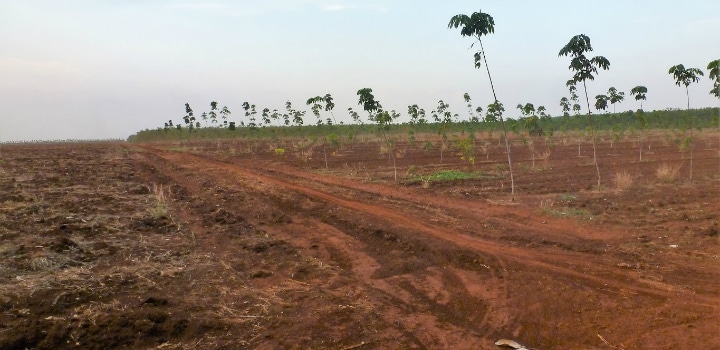Mar 7 2018
According to researchers from the University of East Anglia, efforts to safeguard tropical forests in Southeast Asia for the carbon they store may be unsuccessful as protection payments are extremely low.
 Image credit: University of East Anglia
Image credit: University of East Anglia
A research published on March 5, 2018, in Nature Communications discovers that schemes meant to protect tropical forests from clearance based on the carbon they store do not pay adequately to compete financially with potential revenues from rubber plantations.
Without bigger financial compensation for forest carbon credits, cutting forests down will continue to be more lucrative than protecting them.
Carbon credits are presently priced at $5-$13 per ton of CO2 on carbon markets. But this doesn’t match the real break-even cost of protecting tropical forests from conversion to rubber in Southeast Asia – between $30 and $51 per ton of CO2.
The study was led by the University of East Anglia, in partnership with researchers from the universities of Copenhagen, Exeter, Oxford and Sheffield, and the Wildlife Conservation Society.
Lead researcher Eleanor Warren-Thomas, from UEA’s School of Environmental Sciences, currently working at the University of York, said: “Forests are being converted into rubber plantations in Southeast Asia – especially in Cambodia, China, Laos, Myanmar, and Vietnam.”
“Rubber production covers a massive area – 8.6 million hectares - which equates to around two-thirds of the land used for oil palm plantations.”
“Some of this area is traditional rubber agroforestry, but recent expansion has been of intensive monocultures. Demand for natural rubber, driven by the tire industry, has driven this expansion. The consequences for biodiversity and climate change are very similar to that of oil palm. But rubber has not faced the same level of public scrutiny.”
“It’s a big problem because these forests are irreplaceable. They are globally unique ecosystems, supporting many threatened animals, birds and plants, as well as exceptionally valuable luxury timbers such as rosewood.”
“They also help mitigate global climate change by absorbing and storing CO2. Because of this, they are worth a lot to climate change mitigation efforts.”
Forests which are kept untouched absorb and store carbon – this process can be converted into ‘carbon credits’ which can be offered to organizations, individuals, or even countries, to offset their own carbon emissions, or in broader efforts to fight global climate change.
The service forests provide by absorbing and storing carbon is so vital that financial incentives to decrease deforestation and forest degradation (termed ‘REDD+’) were added in the Paris Agreement at the COP21 international climate negotiations in 2015.
The research team concentrated on Cambodian forests, where trees grow as tall as 55 m, and examined whether carbon credits are sufficient to protect the forests by working out the amount of carbon held by the trees, and the amount of revenue which could be acquired by logging and conversion to rubber.
We collaborated with the Wildlife Conservation Society and the Forestry Administration of Cambodia, who have been working to establish a forest carbon project in Cambodia, and researchers from the universities of Copenhagen, Exeter and Oxford. They contributed their detailed and hard-won field measurements of forests to make this research happen.
This allowed us to make detailed and careful measures of both the carbon and the timber value of these forests.
Eleanor Warren-Thomas
The team then began to calculate how much each ton of CO2 should be valued at to match foregone profits from rubber and timber profits – the ‘break-even’ carbon prices.
The break-even price had to offset all the profits from logging and conversion to rubber plantations, is a lot higher ($30-$51 per ton of CO2) than the prices presently paid on carbon markets ($5-$13 per ton of CO2), but is similar to or lesser than the social cost of carbon (at least $36 per ton of CO2). This social cost is the projected economic damage caused by a discharged ton of CO2.
Eleanor Warren-Thomas said: “It makes sense on a global scale to protect these forests and reduce CO2 emissions, rather than let the emissions happen and do economic damage. But, we show that current carbon prices need to be higher to incentivize forest protection.
“Forest carbon credits place an economic value on the carbon storage ecosystem service provided by forests – we know that there are many other reasons why a forest might be conserved, aside from just the financial incentives offered by carbon finance, but carbon schemes are considered a useful tool in the battle against climate change and deforestation.”
“Forests are less likely to be protected using carbon finance if the payments coming in are much lower than the profits the forest would generate if cut down. We show that where demand for land for rubber plantations is driving deforestation, carbon payments are unlikely to appear an attractive alternative.”
“We also show that if you take away the threat of rubber, the profits from logging on its own seem to be sufficiently low for carbon finance to be a competitive alternative. That said, we may have undervalued some of the timber in our study because the trade of rare but very high-value species, such as rosewood, is illegal and we know little about how much money is being made.”
“The threat of rubber could be reduced by the zero-deforestation pledges that have already been made by big tire companies, government regulations, or enforcement of existing forest protection laws. But ultimately, the demand for natural rubber might only be mitigated by further development of synthetic alternatives or improvements in recycling natural rubber.”
The research paper ‘Protecting tropical forests from the rapid expansion of rubber using carbon payments’ is published in the Nature Communications journal on March 2, 2018.